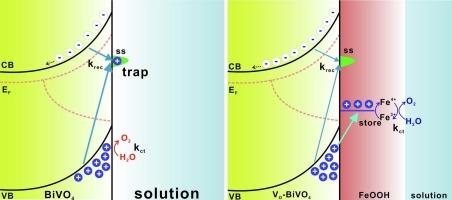Insights into the enhancement mechanism of FeOOH/VO-BiVO4 photoanodes for water oxidation with intensity-modulated photocurrent spectroscopy
IF 4.7
3区 化学
Q2 CHEMISTRY, PHYSICAL
Journal of Photochemistry and Photobiology A-chemistry
Pub Date : 2025-09-02
DOI:10.1016/j.jphotochem.2025.116737
引用次数: 0
Abstract
To overcome the rapid charge recombination and sluggish water oxidation kinetics, FeOOH/VO-BiVO4 photoanodes were rationally prepared. The highest photocurrent density of 3.5 mA cm−2 was generated by the FeOOH/VO-BiVO4 photoanodes at 1.23 VRHE, which was 3.5-fold higher than that of the pristine BiVO4. The dominate enhancement mechanism can be ascribed to significantly increased charge transfer efficiency by the FeOOH overlayers. Intensity-modulated photocurrent spectroscopy revealed that such increased charge transfer efficiency was resulted from the strong suppression of surface recombination by the FeOOH overlayers. Rate constant of surface recombination was strongly reduced to approximately 10−2 s−1 at 0.93–1.23 VRHE. The strongly suppressed surface recombination was attributed to the storage capacity of the FeOOH for the photogenerated holes. Meanwhile, oxygen vacancies just had a minor impact on the kinetics of charge transfer and surface recombination but slightly increased the charge separation efficiency in the bulk. This work clarifies the roles of oxygen vacancies and the FeOOH overlayers in the increased photocurrent density, facilitating the rational design of high-performance BiVO4-based photoanodes.

FeOOH/VO-BiVO4光阳极对水氧化的增强机理研究
为了克服电荷复合快速和水氧化动力学缓慢的问题,合理制备了FeOOH/VO-BiVO4光阳极。FeOOH/VO-BiVO4光阳极在1.23 VRHE下产生的最大光电流密度为3.5 mA cm−2,是原始BiVO4的3.5倍。主要的增强机制可归因于FeOOH覆盖层显著提高了电荷转移效率。强度调制光电流谱分析表明,这种电荷转移效率的提高是由于FeOOH覆盖层对表面复合的强烈抑制。在0.93-1.23 VRHE条件下,表面复合速率常数显著降低至约10−2 s−1。这种表面复合被强烈抑制的原因是FeOOH对光生空穴的存储能力。同时,氧空位对电荷转移动力学和表面复合动力学的影响较小,但对体内电荷分离效率有轻微的提高。这项工作阐明了氧空位和FeOOH覆盖层在增加光电流密度中的作用,有助于合理设计高性能bivo4基光阳极。
本文章由计算机程序翻译,如有差异,请以英文原文为准。
求助全文
约1分钟内获得全文
求助全文
来源期刊
CiteScore
7.90
自引率
7.00%
发文量
580
审稿时长
48 days
期刊介绍:
JPPA publishes the results of fundamental studies on all aspects of chemical phenomena induced by interactions between light and molecules/matter of all kinds.
All systems capable of being described at the molecular or integrated multimolecular level are appropriate for the journal. This includes all molecular chemical species as well as biomolecular, supramolecular, polymer and other macromolecular systems, as well as solid state photochemistry. In addition, the journal publishes studies of semiconductor and other photoactive organic and inorganic materials, photocatalysis (organic, inorganic, supramolecular and superconductor).
The scope includes condensed and gas phase photochemistry, as well as synchrotron radiation chemistry. A broad range of processes and techniques in photochemistry are covered such as light induced energy, electron and proton transfer; nonlinear photochemical behavior; mechanistic investigation of photochemical reactions and identification of the products of photochemical reactions; quantum yield determinations and measurements of rate constants for primary and secondary photochemical processes; steady-state and time-resolved emission, ultrafast spectroscopic methods, single molecule spectroscopy, time resolved X-ray diffraction, luminescence microscopy, and scattering spectroscopy applied to photochemistry. Papers in emerging and applied areas such as luminescent sensors, electroluminescence, solar energy conversion, atmospheric photochemistry, environmental remediation, and related photocatalytic chemistry are also welcome.

 求助内容:
求助内容: 应助结果提醒方式:
应助结果提醒方式:


